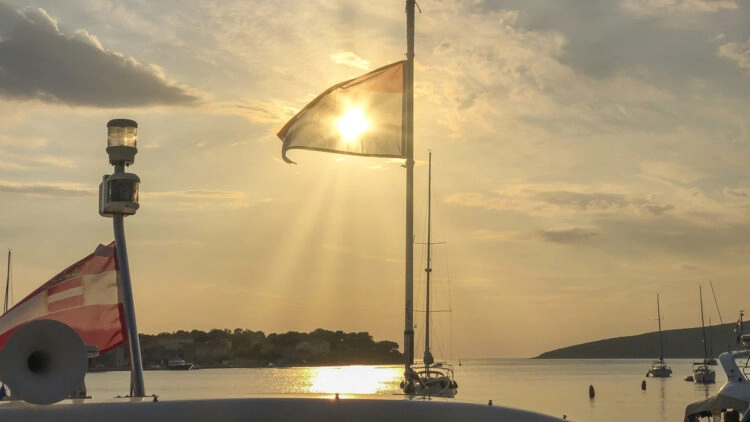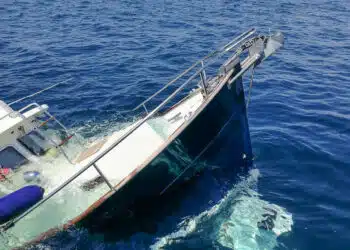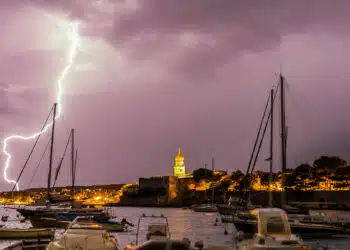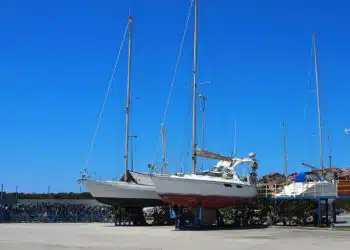The correct light guidance (setting of navigation lights, carrying of lights) is defined – for Germany – in the Collision Prevention Regulations (KVR), the Seeschifffahrtsstraßen-Ordnung (SeeSchStrO) or the Binnenschifffahrtsstraßen-Ordnung (BinnenSchStrO) are regulated to prevent collisions and accidents. Which lights are mandatory on recreational boats? When do they have to be carried? – Skipper tips from the SeaHelp editorial team for a successful trip.
First of all, the (electric) lights must be kept on boats and ships from sunset to sunrise, as well as during the day in uncertain weather at sea and in the fairway. This is to prevent collisions and accidents on the water. A distinction is made between side lights, top lights, stern lights, towing lights, rotating lights and sparkling lights.
In addition, a certain range of between one and six nautical miles is prescribed for all lights. Navigation lights approved by the BSH correspond to a national approval and are marked with a type number. Equipment approved by the German Hydrographic Institute (DHI) remains valid. Navigation lights approved by a notified body correspond to an EU approval according to MED and are marked with a steering wheel. Attention: a CE mark does not replace the approval according to the KVR!
Rules for Yachts under 20 meters length
Yachts under sail less than 20 meters in length must thereafter carry side lights in two-color lanterns and a stern light, alternatively a three-color lantern. It is also possible to carry a red all-round light above a green one. The minimum carrying distance is two nautical miles.
Under motor a top light (3 nm) is to be led at least 2.50 meters above the gunwale, side lights in two-color lanterns (2 nm) as well as a stern light (2 nm). If sailing at the same time, a motor cone must be set. If the yacht is unable or hindered to maneuver, sailing trouble lights (2 nm) as well as sailing trouble tag lights must be carried. At anchor, an anchor light or an anchor ball must be set. If the yacht is aground, ground seater lights are to be led (2 nm) or ground seater balls.
Simplified requirements for yachts under 12 meters in length
Yachts under sail less than 12 meters in length must also carry sidelights in two-color lanterns, but the minimum carrying distance here is only one nautical mile (KVR) or two nautical miles (SeeSchStrO). In addition, a stern light (2 nautical miles) or a three-color lantern (KVR) is required.
According to the SeeSchStrO, a white all-round light (2 nm) can be carried if lanterns cannot be permanently mounted. If this lantern cannot be permanently mounted either, navigation is prohibited at night and in poor visibility (unless there is an emergency – in which case a white light must be carried on board at all times).
Differences between yachts under sail and under engine
.
Yachts under power under 12 meters in length must carry a top light (2 sm) at least one meter above the sidelights – sidelights in two-color lantern (1 sm according to KVR, 2 sm according to SeeSchStrO) and a stern light (2 sm). Alternatively, an all-round light (2 nm) can be mounted instead of top and stern lights (a motor cone must be set if sailing at the same time).
If the yacht is unable or disabled to maneuver, no sailing trouble lights or tags are required here. In case of diving work, however, at least flag “A” of the International Signal Book or a red over white over red rotating light must be set (KVR). According to SeeSchStrO, no navigation trouble lights or day signals need to be displayed, even during diving operations.
Before anchoring, a anchor light to be set (2 nm) or an anchor ball (KVR). According to SeeSchStrO, an anchor ball and anchor light are not required on announced anchorages and moorings. If the yacht is aground, anchor lights and anchor balls are not required (KVR); according to the SeeSchStrO, they are only required in narrow fairways and the like. There are further simplifications for yachts and boats under seven meters in length.
Klicken Sie auf den unteren Button, um den Inhalt von drive.google.com zu laden.
Fine looms – skipper and owner responsible for position lanterns
In general, however, the skipper and owner of the yacht are responsible for ensuring that the effectiveness and operational safety of the position lanterns are maintained at all times. If the effectiveness or operational safety is recognizably impaired, they must immediately ensure that it is properly repaired; any repair may only be carried out at a BSH-approved repair facility, by which it must also be certified.
Incidentally, anyone who equips his ship with non-approved “poses”, carries them incorrectly fitted or incorrectly shielded, or fails to ensure that they are immediately repaired at a recognized repair facility, is not committing a “peccadillo”: it is then an administrative offense that can be punished with a fine.













